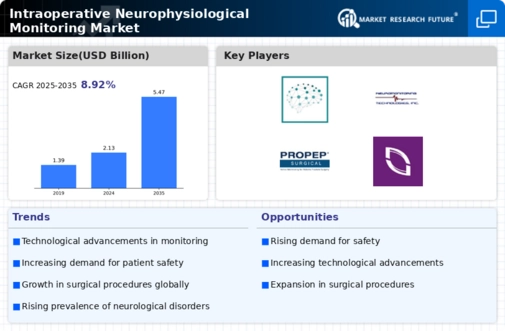Market Trends
Key Emerging Trends in the Intraoperative Neurophysiological Monitoring Market
The intraoperative neurophysiological monitoring (IONM) industry is currently undergoing rapid transformation, marked by a surge in patients afflicted by cerebrovascular disorders, reaching unprecedented levels in recent years. This escalation has been notably linked to a significant increase in surgeries addressing these disorders. Incidents such as vehicular accidents, spinal injuries, and cranial injuries contribute significantly to the upswing in neurosurgical procedures. Given the critical nature of neurosurgeries and spinal surgeries, continuous monitoring throughout these intricate processes proves advantageous, providing real-time insights into electrical signals in the brain and nerves. In this context, intraoperative neurophysiological monitoring techniques play a pivotal role, particularly as they are employed in a wide spectrum of surgical procedures, including spinal, orthopedic, cardiovascular, ENT, and genitourinary surgeries. Consequently, the demand for IONM services is witnessing a notable rise, propelled by the increasing frequency of surgeries, thereby influencing the growth of the intraoperative neurophysiological monitoring market. The ubiquity of IONM is evident as it finds application in various surgical procedures. Physicians engage in continuous monitoring throughout surgeries, aiding in comprehending the intricacies of each case. IONM becomes especially beneficial in complex surgeries, where it helps prevent post-operative injuries by generating alerts through the monitoring process. The continuous monitoring approach significantly diminishes the likelihood of undesirable consequences during surgery. Each instance where an adverse outcome is averted translates into a substantial reduction in the overall treatment cost. Anticipating and efficiently neutralizing complicated conditions before they manifest leads to cost savings in the treatment process. Consequently, individuals undergoing surgeries without the utilization of IONM are prone to incurring higher total treatment costs compared to those who opt for IONM. This cost-effectiveness has prompted a growing number of individuals to choose IONM during surgical procedures, thereby contributing to the flourishing expansion of the IONM market.
The comprehensive benefits of IONM extend beyond real-time monitoring to encompass the proactive identification and prevention of potential complications. This not only enhances patient outcomes but also serves as a cost-saving measure in the broader healthcare landscape. The escalating adoption of IONM in various surgical contexts is indicative of the growing awareness among healthcare professionals and patients regarding its instrumental role in ensuring surgical precision and patient safety.
The dynamic landscape of the intraoperative neurophysiological monitoring industry is shaped by the increasing prevalence of cerebrovascular disorders, driving a surge in related surgeries. The pivotal role played by IONM in diverse surgical procedures underscores its relevance and the consequential rise in demand. As healthcare providers and patients alike recognize the manifold advantages of IONM in terms of real-time monitoring, complication prevention, and cost-effectiveness, the industry is poised for continued growth in the evolving landscape of modern healthcare.








Leave a Comment